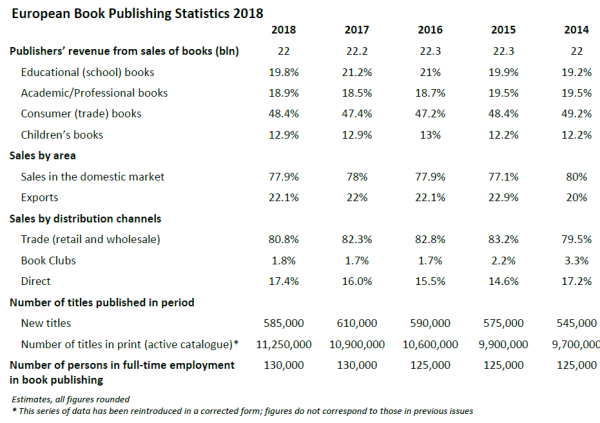For the 2024-2029 mandate, European publishers call on the European Parliament to uphold a vibrant publishing sector, the largest cultural industry in Europe, ensuring that we can continue to freely publish a wide variety of books, guaranteeing freedom of expression, a plurality of opinions and our democratic values.
Search
Members Login
Contact us
European Book Publishing Statistics 2018
10 January 2020
The Federation of European Publishers (FEP) represents 29 national associations of publishers from the European Union and the European Economic Area Member States. The present survey is based on reports from the national book publishing associations, and on further analysis and refining of data, for the year 2018.
Figures on the overall economic significance of the publishing industry refer to net publishers’ turnover, i.e. the publishers’ total revenues from the sales of books, not the total market for books (margin of booksellers or other retailers). They also do not account for revenues in terms of selling rights for translation, audiovisual adaptation, etc. In some cases, only data on market value was available; in such cases, average discount rates were applied to calculate an approximation of net turnover. Figures were rounded conservatively.
The total annual sales revenue of book publishers of the EU and the EEA in 2018 was approximately € 22 billion, according to the survey conducted by FEP. This represents a small decline from 2017 (22.2), due to sluggish growth or small contractions across the majority of markets, although recovery continued in several areas previously affected by the economic crisis. The largest markets in terms of publishers’ turnover in 2018 were Germany, the UK, France, Spain and Italy. Total market value is estimated at 36-38 billion €.
A total of about 585,000 new titles were issued by publishers in 2018. The figure was taken from different sources, some of which included new editions or non-commercial titles, and was accordingly rounded conservatively. There was therefore a decrease in the title output from the previous survey, which had highlighted a spike. European publishers held more than 11 million different titles in stock, the countries reporting the largest availability being the UK, Germany, Italy, France and Spain; this figure, ever-increasing, has been spiked by the surge in digital publishing (in different formats), the digitisation of back catalogues, the growth of print-on-demand services and the surge in self-published titles, as well as other phenomena. The countries reporting the largest new titles output were the UK, Germany, France, Spain and Italy.
A total of approximately 130,000 people were employed full time in book publishing in 2018, a figure substantially equal to the previous year. This remains an area where it is difficult to gather reliable data. The entire book value chain (including authors, booksellers, printers, designers, etc.) is estimated to employ more than half a million people.
Looking at longer term trends, up to 2007 there was steady growth both in terms of turnover and of title output. In 2008 title production kept growing whilst turnover, adjusting for exchange rates, experienced a flat year. 2009 showed a slight decrease in turnover (accounting for exchange rates) and a slowdown of title growth. The crisis had less of an impact on publishing when compared to most other sectors. In 2010, growth resumed (especially exports), although favoured by exchange rates. In 2011 and 2012, the market went down, and title production growth was sluggish; the e-book market grew rapidly and exports were strong. In 2013 and 2014 the market slowed down again, with the most notable trends being the continuous growth of the e-book market and the good performance of exports, which became even stronger from 2015 to 2017, while the e-book market (now around 7-8% of the total) showed signs of stagnation for the last 4 years (but it could be a matter of capturing the right data). Discounting the exchange rate effects, 2017 could be considered the third consecutive year of growth, something that had not happened since the start of the economic crisis in 2008; however, 2018 marked a trend reversal. Title output declined for the first time since 2014.
For further information: Enrico Turrin, +32 2 770 11 10 - eturrin@fep-fee.eu




